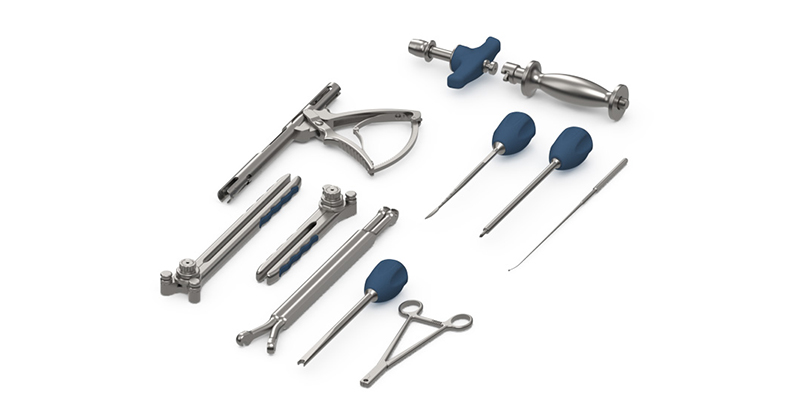
As orthopedic procedures become more advanced, so too do the equipment and instruments that accompany them. The role of instrument suppliers is in the form of a partnership to bring expertise, management and high-quality parts to OEMs as they face the challenges of an evolving market.
We spoke with four instrument suppliers to find out what is top of mind for their customers and learn how they’re helping orthopedic companies develop innovative solutions for better patient outcomes. Unsurprisingly, robotics, outpatient procedures and single-use instruments were among common themes.
Interviewees:
Chad Ryshkus, Director of Marketing and Business Development, MedTorque
Patrick Khalife, Global Director of R&D, Intech
Nader M. Kalkhoran, Director of Technology, N2 Biomedical
Holger Gruenert, President, Pacific Instruments
How are you enhancing orthopedic instruments?
Ryshkus: One of the things we’re focusing on is robotic and navigated instrumentation. Robotic procedures in orthopedics are kind of the buzz nowadays. Certainly, it’s been around in other disciplines, but some of our customers are the leading providers of robotic instrumentation for spinal surgery. We’ve developed the process and integrated vertical machine capabilities in-house to better process these instruments and to ensure control over tolerances.
We’ve recently added the capability to manufacture and bring in processes that were outside, that are high precision processes, that will help with the manufacture of the robotic and surgical navigated instrumentation. We’ve also improved our inspection process and ways that we check parts to ensure that the parts are within spec. So, we have the capability of not just making it, but inspecting it and ensuring that it actually meets the tolerances required.
Khalife: In recent years, we’ve been more and more involved in robotics and navigation projects, not only adapting but also designing ancillaries for guided hip, knee and spine surgeries.
Intech is also home to a technology incubator which produced novel solutions such as Wayvio, a medical device lifecycle monitoring IoT platform. For instance, Wayvio acts as the black box for your medical device. By incorporating Wayvio in their systems, OEMs are steering away from the “no news is good news” mindset and gaining insight on their products’ performance in real-time.
Kalkhoran: N2 Biomedical’s Spectrum NanoCoating is a proprietary process that produces a durable, highly adherent color coating on virtually any reflective substrate, notably stainless steel-based instruments. Our thin ceramic coatings are ideal for facilitating product differentiation, enhancing aesthetics and elevating functionality. The coating is biocompatible and has excellent durability at over 200 cleaning and autoclave cycles. A wide variety of single or multi-tone colors are available. In addition to their durable aesthetic color feature, Spectrum NanoCoatings may also offer functional benefits such as reduced friction in addition to corrosion and wear resistance.
Gruenert: Pacific Instruments enhances orthopedic instruments by sourcing deeply within its global procurement program to balance the OEM’s cost-saving outlook with the production of a reliable and high-quality instrument. Nonetheless, the global pandemic has altered the manufacturing landscape, but the OEM has benefitted from our enhancements because it saves them time and produces a high-quality instrument their surgeon can use and rely on.
What requests are you receiving from OEMs today?
Ryshkus: The larger OEMs are looking for a partner that can handle a greater basket of products in terms of capability, as well as management of vendor managed inventory programs. The small and medium sized companies need to leverage our expertise as manufacturers, and a lot of them don’t have in-house manufacturing. They need somebody that they can rely on to partner with to ensure design for manufacturability is taken into account at the front end, there’s accurate pricing and lead times, and execution around their programs and launches. Some are asking us to manage other vendors because they’re consolidating suppliers.
Khalife: Intech R&D is seeing more and more requests to private-label products as an OEM, responsible for getting regulatory clearance and registering products in various markets. Today, customers come to Intech for our expertise in design, manufacturing and regulatory affairs.
Kalkhoran: We receive a wide range of inquiries from OEMs for enhancing the performance of orthopedic devices and instruments through surface modification. The most common requests are to improve the wear and corrosion resistance as well as to reduce surface friction of these devices, particularly those made of titanium, which are softer and thus more susceptible to wear as compared to CoCr and Stainless Steel.
Gruenert: Cost savings is the top request from OEMs but suppliers, like us, who demonstrate reliability and value, provide them their true lowest cost and OEM partners ultimately reward us over time when they experience it.
How will instruments change over the next five years?
Ryshkus: Major OEMs have invested in some type of robotic system, and they’re going to now integrate a lot of their legacy systems as well as new initiatives. So, that’s going to be a growth area. Also, there is a push to move a lot of procedures to lower cost facilities like ambulatory surgical centers (ASCs). It can’t be a complex procedure that requires 10 cases of instruments; it’s got to be one that is more amenable to a simple or simplified instrumentation or support instrumentation.
Khalife: In the next five years, we expect technology to carry over to a micro-level, thus making instruments and implants “smarter.” As an early-adopter, we want to be at the forefront of digital assistance integration.
Kalkhoran: Rising cleaning standards, particularly in Europe, have increased the requirements that coatings must meet to protect orthopedic instruments. At the same time, increased volume of surgical procedures in ASCs in the U.S. is driving the need for low cost, single use, sterile instruments. Nano-engineered coatings can potentially meet both needs. Durable, protective aesthetic coatings with active antimicrobial properties could revolutionize the orthopedic instrument industry worldwide.
Gruenert: Both high-tech, hand-held surgical instruments and low-tech disposable instruments will further grow. We also see the addition for regulatory management of instruments, and we have started expanding down this path.
(Image courtesy of MedTorque.)
HT
Heather Tunstall is a BONEZONE Contributor.




